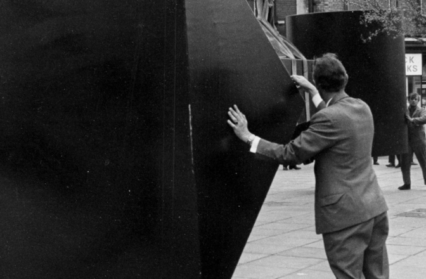Gemma Pearson experiences one of the projects attached to the Garth Evans residency in Chapter Arts Centre in Cardiff, The Cardiff Tapes, a Chapter and Everyman Production.
One day in 1972, a strange object appeared in Cardiff city centre. Dark, steely, and imposing, Cheshire-born Garth Evans’s sculpture was an impressive piece of craftsmanship. The day after it was installed, Evans anonymously recorded the reactions of passers-by. Now, almost fifty years on, these fascinating recordings have come to serve as the inspiration for The Cardiff Tapes, an original play written by Leila Philip and directed by Wayne Vincent. Having found success on the stages of New York in 2017, The Cardiff Tapes is currently showing in Wales for the very first time, coinciding with the imminent return of the sculpture to the city of Cardiff.
The stage is adorned with all the key tenets of its urban setting: a familiar street sign marked ‘The Hayes,’ copious amounts of litter, and a rickety bicycle. But something in particular stands out; a graffitied exclamation demanding “Asians Out” glares from centre stage. Unsettlingly reminiscent of the racism and xenophobia that has surfaced following Britain’s Brexit vote and throughout Trump’s presidential term.
When the lights go down and the stage is plunged into darkness, the audience’s attention is drawn towards a large screen at the back of the stage. A video montage begins and, featuring news footage, music, and photographs from the 1970s, The Cardiff Tapes begins by telling a story of the past. But as the timeline zooms forward to the present day and the visual aids become increasingly topical, audiences are urged to look towards the future. Amidst all of our contemporary racial and political divisions, The Cardiff Tapes – using modern art as its springboard for cultural conversation – encourages us to ask ourselves: “Where do we go from here?”
Following this introductory montage, the audience is thrown back to the 1970s and to the street upon which Garth Evans first gathered opinions on his piece. “It’s a talking point, I suppose,” mediates one onlooker. “It’s modern, innit. Goes with the times,” suggests another. Such utterances are cleverly and pointedly directed towards the audience; we play the part of the behemoth sculpture and become subjected to the scrutiny and the judgements of surveying passers-by. As the performance progresses, new locations and scenes introduce us to new social groups. Actors return to play different characters, each articulating various views on the possible meaning or value of Evans’s sculpture. We garner reactions from builders, housewives, teenagers, shopkeepers, elderly couples, young mothers, and more. When the production comes to an end, the cast receive a well-deserved standing ovation from a few very happy theatre goers.
The Cardiff Tapes is scripted entirely around the recordings gathered by Garth Evans that day. As a result, the production is creative in its approach to narrative by avoiding a clear storyline or much linearity. But this is the beauty of the production. With this approach, The Cardiff Tapes effectively imitates the confusion, the debate, and the intrigue surrounding Evans’s “provocative” installation.
Modern art has famously divided opinions of onlookers. But isn’t that the point of modern art – to cross borders, carve out space for cultural discussion, challenge opinions, and spark emotive responses? The Cardiff Tapes examines these issues with considerable dexterity, intertwining humour and sincerity with a lightness of touch that renders the production entertaining and thoroughly thought-provoking. The production’s recurring use of contemporary visual media to highlight cultural conflicts – such as racism, ableism, and anti-LGBTQA+ sentiments – reminds us that society is always at risk of moving backwards. By holding up a mirror to society, modern art can help us to move forward. In light of this, The Cardiff Tapes director Wayne Vincent is right; amidst our turbulent cultural epoch, a period characterised by political unrest and a rise in racial tensions, the question on everyone’s lips should be “Where do we go from here?”
You might also like…
Dylan Moore attended Patti Pavilion, Swansea to witness a collaboration between National Theatre Wales and Frantic Assembly – Little Dogs.
Gemma Pearson is a regular contributor to Wales Arts Review.



 Enjoyed this article? Support our writers directly by buying them a coffee and clicking this link.
Enjoyed this article? Support our writers directly by buying them a coffee and clicking this link.








